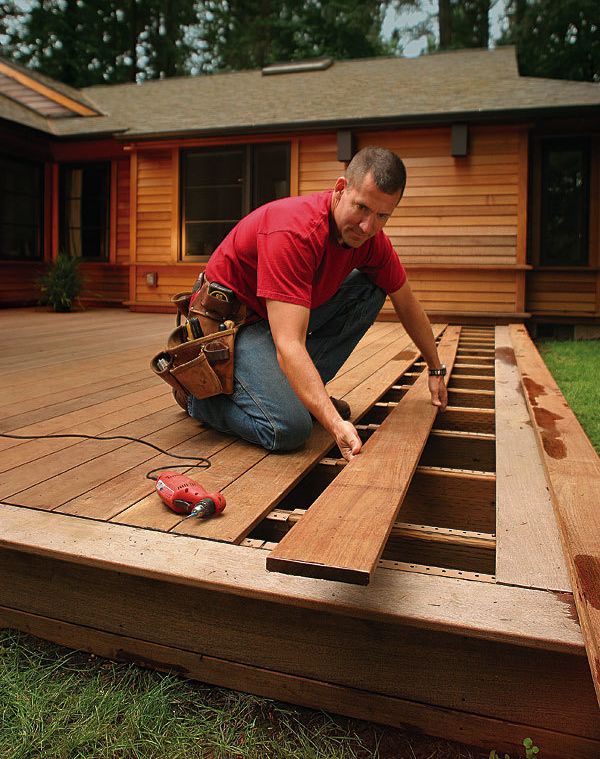Build A Grade-Level Deck With Custom Details
Simple details help this low-lying deck make a graceful connection to the outdoors.

Synopsis: A grade-level deck can keep dirt from entering the house and also create an inviting outdoor space by gracefully tying the house to the yard. Dirt mitigation is easy enough, but a graceful tie-in can provide more of a challenge. A few simple details can add up to an exceptional package. Picture-framing is a clean way of hiding the visible ends of the deck boards by running a long deck board perpendicular to those ends, giving them something to die into. Inside corners are a perfect spot to run a herringbone weave; 45° miters only open over time, and having a stark junction of perpendicular boards interrupts the flow of a deck. Removable panels in the deck can accommodate a small tree that can be planted after the deck is completed.
My clients were frustrated with their house, a 1960s-style ranch that had just been renovated. Once this long process was over, they quickly realized two things: First, having the kids play outside meant that a little bit of yard rode in on their feet every time they entered the house (this is Portland, Ore.); and second, the two doors opening to the backyard weren’t leading to a welcoming destination.
Even when the renovation got under way, there had been talk of a deck in the backyard, but those discussions were sidelined in the push to get back into the house. Now the homeowners knew they needed to structure the yard both to mitigate the dirt entering the house and to create an inviting outdoor space. Because I had done the renovation, I had a good sense of both the house and their needs. Dirt mitigation is easy enough, but “inviting” provided more of a challenge.
I ended up building a long wraparound deck positioned to catch the most sun on this forested site. The largest section adjoins the public part of the house, with a smaller platform off the master bedroom. The two sections are connected by a narrower strip of decking that runs along the side of the bedroom wing.
One deck with multiple details
Linking the two sections gave me the opportunity to build in a few features that would make this simple, on-grade deck stand out. To start, I wanted a picture-frame border. Picture-framing is a clean way of hiding the visible ends of the deck boards by running a long deck board perpendicular to those ends, giving them something to die into. Because the deck turns a corner and wraps partway around the house, I faced having a field of deck boards running at right angles to each other. This would be a perfect spot to run a herringbone weave; 45° miters only open over time, and having a stark junction of perpendicular boards interrupts the flow of a deck.
The homeowners also requested an opening with removable panels in the deck to accommodate a small tree. Because this tree was to be installed after I completed the project, I had to frame the opening in a way that would support removable deck panels that went around the tree and also would allow the landscapers to remove enough of the deck frame so that they could plant the tree.
Although the appeal of each of these features is primarily visual, modifying the framing is the first step in constructing each of them, and what I’ll focus on here.
For more photos and details, click the View PDF button below:
Fine Homebuilding Recommended Products
Fine Homebuilding receives a commission for items purchased through links on this site, including Amazon Associates and other affiliate advertising programs.

Drill Driver/Impact Driver

4-Gallon Piston Backpack Sprayer

Standard Marking Chalk


























